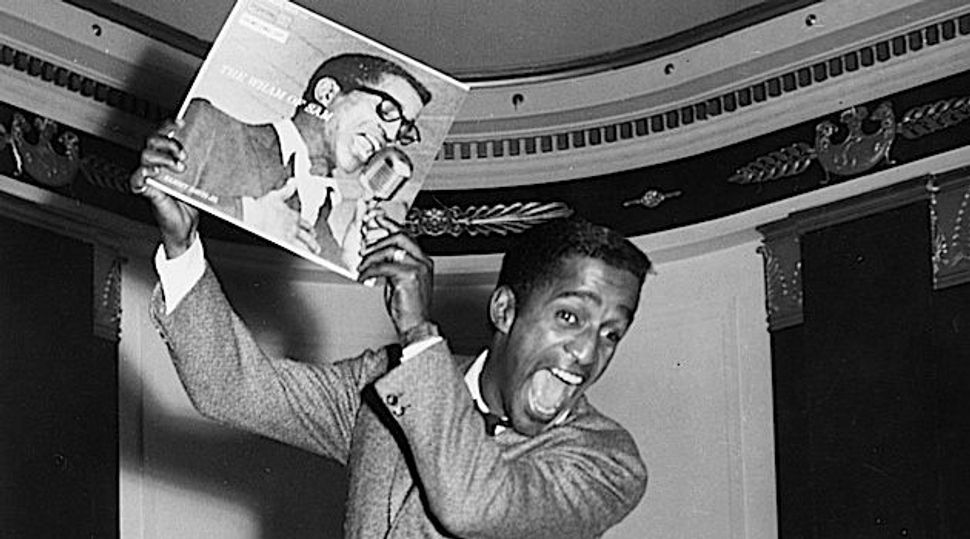How Sammy Davis Jr. Became the Great Jewish Entertainer

The Accidental Jew: Sammy Davis Jr. converted to Judaism after a near-fatal car accident. Image by Getty Images
● Sammy Davis Jr.: A Personal Journey with My Father
By Tracey Davis and Nina Bunche Pierce
Running Press, 208 pages, $30
‘Even when my own people would complain to me about racism,” Sammy Davis Jr. told his daughter shortly before the end of his life, “I would always say, ‘You got it easy. I’m a short, ugly, one-eyed black Jew. What do you think it’s like for me?’”
It was a riff that Davis regularly recycled for laughs — but as was so often the case for the multi-talented entertainer, there was considerable truth and pain behind the punch line. Indeed, truth, pain and laughter are all prominent themes in “Sammy Davis Jr.: A Personal Journey with My Father,” a sumptuously illustrated book by Davis’s daughter Tracey (with collaborator Nina Bunche Pierce) that looks back on his career through the prism of their final months together.
As Ms. Davis recounted in her previous book, 1996’s “Sammy Davis Jr.: My Father,” it wasn’t easy growing up as the daughter of one of the world’s most in-demand song-and-dance men, a workaholic father who tried to make up for his lengthy absences with lavish expenditures and extravagant gestures. Here, however, she makes a conscious effort to leave the bitterness and baggage behind, savoring instead the memories of the conversations she shared with her father in 1990 while he was losing his battle with throat cancer. It was during this period, she writes, that “my father became particularly nostalgic about the past,” and seemed to particularly relish the chance to revisit and reflect upon his struggles and accomplishments with his once-estranged daughter (then pregnant with his first grandson) as his audience.
Though Ms. Davis did not record their conversations, she does her best to reconstruct them from memory here, and they touch chiefly (and often all-too-briefly) upon the major bullet points of her father’s biography: learning the showbiz ropes as a child with his father in the Will Mastin Trio; being verbally and physically abused by white soldiers while serving in the United States Army during World War II; his postwar rise to fame; his decades-long friendship with Frank Sinatra; his near-fatal car accident that caused him to lose an eye; his post-accident conversion to Judaism; the heady days in Las Vegas with “The Rat Pack”; the controversy over his interracial marriage to Swedish actress May Britt (Tracey’s mother) in 1960; their 1968 divorce; and his 1970 marriage to dancer Altovise Gore, whom he met during his Tony-nominated Broadway turn in “Golden Boy.”
Absent (perhaps understandably so) are the more tawdry and salacious aspects of Davis’s life, like his affair with actress Lola Falana, his penchant for “swinging” in the non-musical sense, or his involvement with Anton LaVey’s Church of Satan. Davis’s drug use and alcoholism are, likewise, only lightly touched upon here. Aside from some pointed digs at her stepmother — whom Ms. Davis claims was such a raging alcoholic that her father locked her out of his wing at their Beverly Hills mansion during his final months — family drama is largely kept at bay, as well.
As such, little in “Sammy Davis Jr.: A Personal Journey with My Father” will come as any sort of revelation to longtime fans of the entertainer. And while the 100-plus photographs included here amply attest to Davis’s striking charisma — as well as to his innate ability to lend pizazz to even the stiffest of occasions, such as his 1971 appointment by former President Nixon to the National Advisory Council on Economic Opportunity (to which Sammy un-ironically sported a peace medallion) — their placement in the book often seems haphazard, and their captions frustratingly sparse. Ms. Davis is solid enough at fleshing out her father’s reminiscences with historical and cultural context, but she’s on shakier ground when ruminating on the bigger picture, offering up shallow epiphanies like, “I looked around at the plush garden oasis my pop worked so hard for, and thought, ‘Wow, my father really is a megastar.’”
Still, for all its flaws, “Sammy Davis Jr.: A Personal Journey with My Father” is sweetly intimate and often quite engaging. The affection that Ms. Davis and her father had for each other rings loud and true, as does her father’s passion for living; his deep sadness at losing his ability to perform — which he quite clearly held tantamount to losing his life — is heartbreakingly palpable. The writing of this book obviously provided Ms. Davis with another chance to commune with her father’s spirit, and it’s hard to fault her for wanting to do that. Even through decades-old conversations, the wit and charm of Sammy Davis Jr. remain as winning as ever, and readers will come away feeling as if they’ve spent some quality time with the man. Even if they don’t learn much new from the experience, they’ll be entertained — and that’s exactly the way Sammy would want it.
Dan Epstein is the author of “Stars and Strikes: Baseball and America in the Bicentennial Summer of ’76.”

















